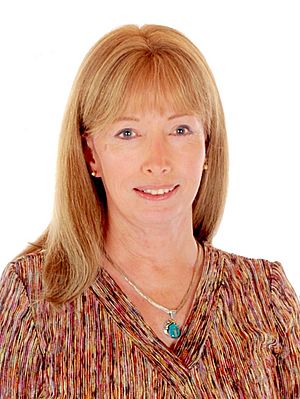Lynn Conway facts for kids
Quick facts for kids
Lynn Conway
|
|
|---|---|

Conway in 2006
|
|
| Born | January 2, 1938 Mount Vernon, New York, U.S.
|
| Died | June 9, 2024 (aged 86) Jackson, Michigan, U.S.
|
| Alma mater | Columbia University |
| Known for |
|
| Spouse(s) |
Charles Rogers
(m. 2002) |
| Awards |
|
| Scientific career | |
| Fields | |
| Institutions | IBM Advanced Computing Systems (1964–68), Memorex, Xerox PARC (1970s), DARPA, University of Michigan |
Lynn Ann Conway (January 2, 1938 – June 9, 2024) was an American computer scientist, electrical engineer, and a strong voice for transgender rights.
In the 1960s, while working at IBM, she created an important invention called "generalized dynamic instruction handling." This idea is used in almost all modern computer processors to make them work faster. She also started a big change in how microchips are designed, known as the Mead–Conway VLSI chip design revolution. This new way of designing chips spread quickly in the 1980s. It helped create many new companies that design and make computer chips today.
Contents
Early Life and Learning
Lynn Conway grew up in White Plains, New York. She was born and lived as a boy, but she felt that her true identity was female. As a child, she was shy but loved astronomy. One summer, she even built her own telescope. She was very good at math and science in high school.
In 1955, Conway started studying at MIT. She earned good grades but left in 1958. After working for a few years as an electronics technician, she went back to school. She studied at Columbia University and earned two degrees in electrical engineering by 1963.
Important Work at IBM
In 1964, Lynn Conway was hired by IBM Research. She soon joined a special team that was designing a very powerful computer called a supercomputer. While there, she invented a new way for computers to handle instructions, which made them much faster. This invention is still used in many modern computer chips. Experts say that the computer she worked on was one of the first to use this super-fast design.
Career as a Computer Scientist
In 1968, Lynn Conway started a new chapter in her life. She took on a new name and identity, and began her career again as a computer programmer. From 1969 to 1972, she worked at Memorex, designing digital systems and computer parts.
Innovations at Xerox PARC
Conway joined Xerox PARC in 1973. There, she led a group focused on LSI systems. At PARC, she created a new method called "multiproject wafers" (MPW). This allowed many different circuit designs to be put onto one single silicon wafer. This invention made it cheaper and easier to produce computer chips.
Working with other scientists, she co-wrote a very important book called Introduction to VLSI Systems. This book became a standard textbook for designing chips. By 1983, nearly 120 universities were using it, and over 70,000 copies were sold. Her new ideas, combined with the MPW technology, changed how VLSI chips were designed forever.
Teaching and Spreading New Ideas
In 1978, Conway taught a famous course at MIT about VLSI design. She used a draft of her new textbook. This course proved that her new design methods worked well. It also set the standard for how these courses would be taught around the world.
One of Conway's key inventions was a set of simple rules for designing chips. These rules made it much easier to create complex chips. She also helped create a new internet-based system for quickly making test versions of chip designs. This system, called Metal Oxide Semiconductor Implementation Service (MOSIS), started in 1981. It helped solve the problem of chips becoming more and more complex.
Since it began, MOSIS has made over 50,000 different circuit designs for companies, government groups, and schools. This system made it possible for universities and smaller companies to use the latest computer chip technology, just like big companies.
Work at DARPA and University of Michigan
In the early 1980s, Conway joined DARPA, a research agency for the U.S. Department of Defense. She helped create a major research program focused on powerful computing, self-driving systems, and smart weapons.
A colleague once said that Lynn Conway "would like to live five lives in the course of one life" because she was so energetic. Another said, "She figures out a way so that everybody wins."
In 1985, Conway became a professor at the University of Michigan. She taught electrical engineering and computer science. She also worked on how internet and cable communications could be combined for visual communication. She retired in 1998 as a professor emerita.
Personal Life
Before she transitioned, Lynn Conway was married and had two children.
In 1987, Conway met Charles "Charlie" Rogers, who became her husband. They shared a love for outdoor activities like whitewater canoeing and motocross racing. They got married on August 13, 2002.
Lynn Conway passed away on June 9, 2024, at her home in Jackson, Michigan, due to a heart condition.
Awards and Honors
Lynn Conway received many awards and honors for her amazing work:
- Electronics 1981 Award for Achievement (with Carver Mead)
- Harold Pender Award (with Carver Mead), 1984
- Fellow of the IEEE, 1985
- John Price Wetherill Medal (with Carver Mead), 1985
- Secretary of Defense Meritorious Civilian Service Award, 1985
- Member of the National Academy of Engineering, 1989
- Computer Pioneer Award, IEEE Computer Society, 2009
- Fellow Award, Computer History Museum, 2014
- IEEE/RSE James Clerk Maxwell Medal, 2015
- Honorary Doctorate, University of Michigan, 2018
- Lifetime Achievement Award, IBM Corporation, 2020
- Induction into the National Inventors Hall of Fame (NIHF), 2023
See also
 In Spanish: Lynn Conway para niños
In Spanish: Lynn Conway para niños

